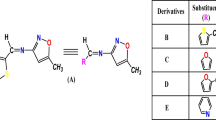Abstract
Indolocarbazole derivatives have already been reported to be good organic semiconductor candidates. The knowledge of the relationship between the structure and packing of molecules in crystal is indispensable in design of high performance organic semiconductor materials. Two new indolocarbazole derivatives, 2,8-dibromo-5,11-di-[4-(isoindole-1,3-dione-2-yl)butyl]indolo[3,2-b]carbazole (I) and 2,8,6,12-tetrabromo-5,11-di-(4-chlorobutyl)indolo[3,2-b]carbazole (II) have been synthesized and the crystal structures have been studied. The dichloromethane solvate of (I), C42H32Br2N4O4 · 2CH2Cl2, is monoclinic, space groups P21/n. Unit cell parameters are a = 11.6847(2), b = 12.6942(2), c = 13.7899(2) Å, β = 91.8220(10)°. Unlike other indolo[3,2-b]carbazole derivatives, there is no any π–π stacking between the indolocarbazole backbone of two adjacent molecules in the crystal. Since the isoindole-1,3-dione-2-yl is introduced in 5- and 11-positions in the molecule, the intermolecular short contacts mainly localize in between the pendant groups of the neighboring indolocarbazole molecules. The compound (II) is also monoclinic with P21/c space groups. Unit cell parameters are a = 4.6427(9), b = 11.425(2), c = 24.511(4) Å, β = 93.47(1)°. In contrast with compound (I), the molecules of (II) possess strong face-to-face π–π stacking. The crystal structures were studied in detail. It is concluded that linear pedant groups benefit to co-facial π–π interaction. Additionally, the molecule electronic spectra were studied by quantum chemistry theoretical calculation.





Similar content being viewed by others
References
Hu NX, Xie S, Popovic Z, Ong BS, Hor AM (1999) J Am Chem Soc 121:5097. doi:10.1021/ja9906554
Hu NX, Xie S, Popovic Z, Ong BS, Hor AM (2000) Synth Met 111–112:421. doi:10.1016/S0379-6779(99)00387-2
Li Y, Wu Y, Gardner S, Ong BS (2005) Adv Mater 17:849. doi:10.1002/adma.200401290
Wu Y, Li Y, Gardner S, Ong BS (2005) J Am Chem Soc 127:614. doi:10.1021/ja0456149
Zhao HP, Tao XT, Wang P, Ren Y, Yang JX, Yan YX, Yuan CX, Liu HJ, Zou DC, Jiang MH (2007) Org Electron 8:673. doi:10.1016/j.orgel.2007.05.001
Campbell RB, Trotter J, Robertson JM (1961) Acta Crystallogr 14:705. doi:10.1107/S0365110X61002163
Klauk H, Halik M, Zschieschang U, Schmid G, Radlik W, Weber W (2002) J Appl Phys 92:5259. doi:10.1063/1.1511826
Troisi A, Orlandi G (2006) Phys Rev Lett 96:4. doi:10.1103/PhysRevLett.96.086601
Boudreault PT, Wakim S, Blouin N, Simard M, Tessier C, Tao Y, Leclerc M (2007) J Am Chem Soc 129:9125. doi:10.1021/ja071923y
Yudina LN, Bergman J (2003) Tetrahedron 59:1265. doi:10.1016/S0040-4020(03)00029-2
Altomare A, Burla MC, Camalli M, Cascarano GL, Giacovazzo C, Guagliardi A, Moliterni AGG, Polidori G, Spagna R (1999) J Appl Crystallogr 32:115. doi:10.1107/S0021889898007717
Farrugia LJ (1999) J Appl Crystallogr 32:837. doi:10.1107/S0021889899006020
Baerends EJ, Gritsenko OV (1997) J Phys Chem A 101:5383. doi:10.1021/jp9703768
Stowasser R, Hoffmann R (1999) J Am Chem Soc 121:3414. doi:10.1021/ja9826892
Chou YM, Chen WH, Liang CC (2009) J Mole Struct Theochem 894:117. doi:10.1016/j.theochem.2008.10.005
Shukla D, Nelson SF, Freeman DC, Rajeswaran M, Ahearn WG, Meyer DM, Carey JT (2008) Chem Mater 20:7486. doi:10.1021/cm802071w
Lehnherr D, McDonald R, Ferguson MJ, Tykwinski RR (2008) Tetrahedron 64:11449. doi:10.1016/j.tet.2008.09.041
Bao Z, Dodabalapur A, Lovinger AJ (1996) Appl Phys Lett 69:4108. doi:10.1063/1.117834
Meng H, Bendikov M, Mitchell G, Helgeson R, Wudl F, Bao Z, Siegrist T, Chen CH (2003) Adv Mater 15:1090. doi:10.1002/adma.200304935
Acknowledgments
The authors thank the State National Natural Science Foundation of China (Grant Nos. 50721002 and 50603011) and the Scientific and Technology Key Projects Plan of Shandong Province (2008 GG10002026) for financial support.
Author information
Authors and Affiliations
Corresponding authors
Rights and permissions
About this article
Cite this article
Zhang, Q., Ren, Y., Ma, C. et al. Synthesis and structures of two novel indolo[3,2-b] carbazole derivatives. Struct Chem 20, 807–813 (2009). https://doi.org/10.1007/s11224-009-9471-7
Received:
Accepted:
Published:
Issue Date:
DOI: https://doi.org/10.1007/s11224-009-9471-7




